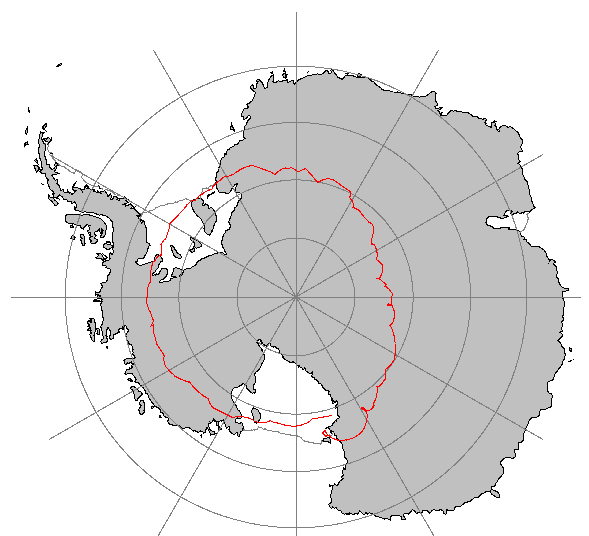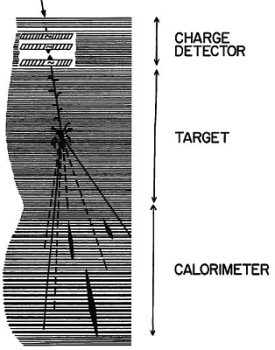Purpose of the flight and payload description
The Japanese American Collaborative Emulsion Experiment (JACEE) was a scientific effort carried out to measure the composition and spectra of primary cosmic rays at the top of the atmosphere, using emulsion chambers transported by stratospheric balloons. JACEE's first flight was conducted in 1979, and flights continued through 1996, totaling 14 flights and 13 successful missions. The collaboration leveraged Japanese expertise in photographic materials and microscopy, American expertise in ballooning and data analysis, and Polish resources in scanning and measurement of emulsions.
Each payload could contain one, three, or four chambers, each chamber with an area about 2000 cm2, 12~25 cm thick, and weighing ~120 kg. Figure at left shows a schematic diagram of the vertical configuration of one chamber. It was comprised of four sections, identifiable according to their function in the experiment. These are, from the top, the charge detector, the target, the spacer, and the calorimeter. All sections were multilayered stacks of track-sensitive materials (emulsions, x-ray films, CR-39, Lexan) alternated with absorbers (acrylic, lead). There were approximately 300 layers of emulsion in the chamber. This configuration was more or less the same for all the flights. However, many flights not included the spacer section, and in some cases were added other elements like Cerenkov detectors or plastic scintillators.
The charge detector employed thick (200 - 400 micron) emulsions, which permited accurate determination of the charge of each primary particle via measurements of the grain density, gap distribution, and/or delta ray distribution. The target section was comprised basically of thin (50 ~ 75 micron) emulsion plates alternated with acrylic sheets. The substantial mass of low-Z material maximized the interaction probability, while the emulsion optimized the observation of charged tracks from an interaction vertex. In order to identify nuclear fragments, charge identification layers composed of thick emulsions and etchable plastics were inserted at regular intervals throughout the target.
The spacer section consisted of honeycomb paper with a few thin emulsions positioned at regular intervals that facilitated the tracing of tracks through it. Finally, the calorimeter was the energy measuring portion of the apparatus. It consisted of 1.0 and 2.5 mm thick lead sheets alternating with thin emulsion plates and x-ray films. Gamma rays emanating from a vertex in the target initiated electro-magnetic cascades in the calorimeter. The cascades produced dark spots in the x-ray films, the observation of which provided the trigger for an event. The events were traced back from the calorimeter, through the spacer, to the vertex in the target by observing associated tracks in the emulsions.
All flights made in Antarctica for JACEE after 1992 used the same gondola design: a simple, lightweight and very rugged framework that provided protection for the emulsion chamber modules in case of an awkward landing or parachute drag, wich also was easy to dissasemble on the landing spot or to be replaced in short notice at a low cost. The payload included an onboard data logging computer which was an adaptation of electronics originally designed for other project to record pressure altitude and module temperatures. The JACEE data logger was interfaced to the NSBF SIP (Support Instrument Package) allowing status monitoring and data downloading during flight.
Details of the balloon flight

Balloon launched on: 12/19/1995 at 7:41 utc
Launch site: Williams Field, McMurdo Station, Antarctica
Balloon launched by: National Scientific Balloon Facility (NSBF)
Balloon manufacturer/size/composition: Zero Pressure Balloon N29EX-8/8/8T-28.40-01
Balloon serial number: R28.40-2X-106
Flight identification number: 412N
End of flight (L for landing time, W for last contact, otherwise termination time): 1/2/1996 at 7:24 utc
Balloon flight duration (F: time at float only, otherwise total flight time in d:days / h:hours or m:minutes - ): 14 d 5 h
Landing site: 93 miles S of McMurdo, Antarctica
Payload weight: 2950 lbs
Overall weight: 4586 lbs
The balloon was launched in near perfect conditions from Williams field, McMurdo Station at 7:41 utc on December 19, 1995. The balloon traveled at an acceptable altitude about 124.000 ft and proceeded along a good path at moderate speed. During the flight were problems associated to the transmission of data. Apparently the flight data logger isolated from the telemetry module. However scientists assumed that the onboard computer was internally logging the data, and simply not transmitting this info to the ground.
After 14 days aloft the balloon made a full turn to the the pole and was approaching back to McMurdo. Termination was transmitted from a C-130 plane flying nearby the balloon on January 2, 1996 at 20:25 local time. The instrument and attached parachute landed on the ice at 79.44º S , 163.05º E about 100 miles SSE of McMurdo. Although the parachute cutaway system to separate it from the gondola did not worked, there was not dragging to the instrument because the parachute collapsed at landing. The recovery of the payload occured on January 6 in three helicopter sorties.
External references
- JACEE experiment website Institute of Nuclear Physics PAN, Poland
- JACEE experiment website University of Washington Particle Astrophysics Group
- Cosmic Ray Astrophysics from Balloons in Antarctica Astrophysics From Antarctica; ASP Conference Series; Vol. 141; 1998, p.26
- NASA Balloon Flights (1989-1998) in NASA Historical Data Book, Vol. VII: NASA Launch Systems, Space Transportation, Human Spaceflight, and Space Science, 1989-1998
1527If you consider this website interesting or useful, you can help me to keep it up and running with a small donation to cover the operational costs. Just the equivalent of the price of a cup of coffee helps a lot.


